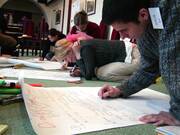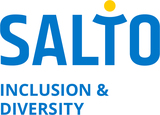Working with People who are Hard of Hearing
- This and a lot more in the SALTO Inclusion for All booklet: No Barriers, No Borders
There is a wide variety of hearing disabilities, ranging from people that hear ok when they use assistive equipment to people who do not hear anything. People that were deaf at birth have learned to communicate in visual ways (e.g. sign language has its own grammar, lexicon and idioms). Speaking or writing a verbal (foreign) language is often a second or third language for them. Some deaf or hard-of-hearing people can lip-read and some use sign language. There are a number of deaf people who have a speech impairment but others speak fluently. Find out what assistive equipment or methods they use for communication.
With a little bit of adaptation you can make your programme suitable for all.
- A sometimes funny mistake many people make, is to start shouting louder at deaf persons when they don't understand. Instead repeat more clearly what you said before (if the deaf person lip-reads), use other words and gestures or allow time for other ways of communication (writing, etc)
- Quite obviously, if the deaf or hard-of-hearing people can lip-read, you will need to speak facing these persons so they can see your lips. Pronounce words clearly and articulately but without overdoing it. Do not obscure your lip movements with your hands, chewing gum, a cigarette, etc
- However, it is not easy to lip-read a foreign language! Also, it is more complicated to read lips of a non-native speaker speaking the language of the lip-reader because the pronunciation or accent (the use of the lips) can be different. Rephrase or explain rather than repeating the same sentence.
- People with hearing impairments need to concentrate on the gestures, expressions and lips of others so well planned lighting and distance is necessary - make sure the background of the speaker is not distracting.
- If you choose to work with a sign language interpreter (between voice and sign language), make sure that you leave enough time for interpreting, and possible questions after that. Speak in coherent blocks, take a pause and when the signing is finished ask your questions to which participants can react. Speak directly to the person, not the interpreter.
- Ask regularly if the interpreter has enough time and ask pro-actively if the participant has a question or something to add. You could learn the basic sign language for "do you understand?" or "is it clear?" and use this regularly.
- Note that sign language is different in different countries! So it usually does not work to have sign language as a communication tool between people with hearing impairments from different countries (even though some basics can be the same).
- Gain deaf people's attention before starting to say (lip) something - i.e. you can tap the person(s) gently on the shoulder or arm, wait till the person turns to you, make a visible gesture or flash the lights of the working room.
- Agree with the group on visual ways to start and end a session or activity, e.g. after a break, rounding off working groups,... - you could switch the lights on & off, use different colour lights, etc it is important is to keep deaf people within visual distance, so that it is easier for you to attract their attention, e.g. for rounding off an exercise and for calling them back again
- The opposite of working with the blind, where it is important to say everything you write, with the deaf you need to write or visualise everything you say (e.g. provide handouts, write on the board or flipcharts,...)
- To make yourself understood, you could act out an exercises or provide an example (e.g. of energisers, games, expected flipcharts coming from group work,...)
- When having group discussions, agree on a sign for the deaf participants which they can use to indicate they want to contribute. Some deaf or hard-of-hearing persons have speech disorders which can make it difficult to understand them - do not feel embarrassed to ask them to repeat. If you don't understand them, say so, and revert to alternative ways of communication (writing, sign language with translation)
- It is useful to carry around a pen and paper if you are with deaf or hard of hearing people and you don't know their sign language. It comes in handy for communicating.
- Some waves (e.g. mobile phones) could interfere with the assistive hearing devices used by the participants that are hard-of-hearing. Make sure they are switched off - the mobile phones of course.
- The Deaf or hearing impaired can party and dance - they can feel the beat (add a bit of extra bass) or dance to the lightshow based on the music (according to rhythm). No need to scrap the disco night from your programme.
- Be clear about roles - who is the personal assistant - who helps when and for what (not). The team cannot be a personal assistant, but they can ask some of the participants to help (e.g. with an exercise)
- ...
^^ top ^^
Accessibility guidelines for people with hearing impairments
- It is possible to install an 'induction loop system' for the benefit of people with hearing aids in the work room(s). With this system the sound is transmitted as a magnetic field, and those with hearing aids designed to receive induction loop sounds can , a bit like a TV aerial. Does your venue have one of these systems or can you rent/take one?
- Deaf and hard of hearing people cannot hear fire alarms. Does your hostel have alarms with stroboscopic lamps and bed-frame vibrators (or other?). Make sure the project organisers know exactly where people with a disability are located in the building in case of emergency - and what to do. You could make an emergency division of tasks for all participants with a disability.
- Is there a Text Telephone (TTY) available? You could find out if there exists a telecommunications relay service, which makes the link between the voice of a caller and the Text Telephone. Alternatively you could have a computer with email or chat function (or sms).
- You can find a special section on aural environment guidelines in the publication Access for All from the website of the Maltese National Commission Persons with a Disability www.knpd.org (www.knpd.org/pubs/pdf/accessforall2005.pdf)
^^ top ^^
Practical tips
- If some participants use hearing aids, make sure to take enough batteries. Some of this equipment is very expensive and fragile. Take out a good insurance, and find out if there is a repair service where you are going.
- If you will be taking an induction loop system, make sure it works in the venue where you will be. Take some back-up cables etc. Talk it through with the technician of the venue what exactly you need.
- You could create a backup communication system via SMS when going into the city (free time) or on excursions
 Inclusion: breaking the invisible wall
Inclusion: breaking the invisible wall

Downloads
The following downloads are available:
- No Barriers No Borders - international mixed-ability projects - 2008 update
How to set up international projects with young people with and without a disability. With lots of tips & tricks about partnerships, funding, working with disability,... Based on SALTO TC Enable 2003
